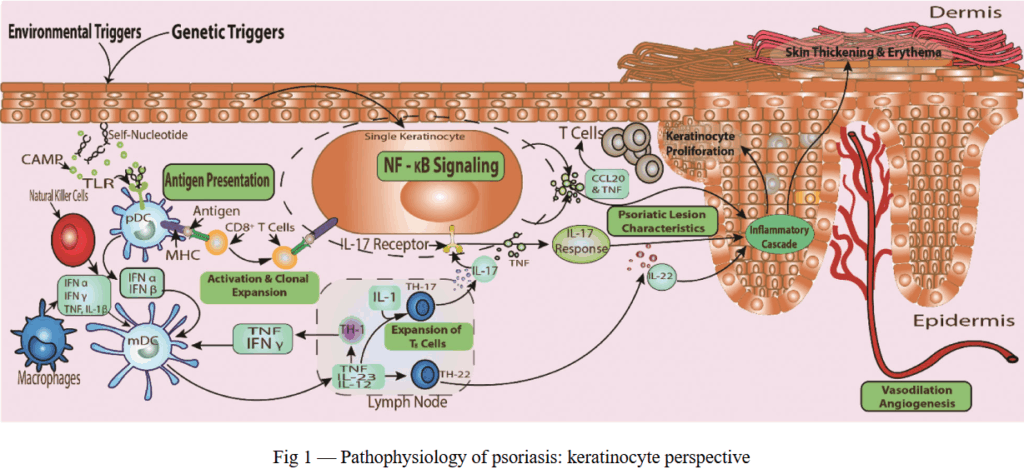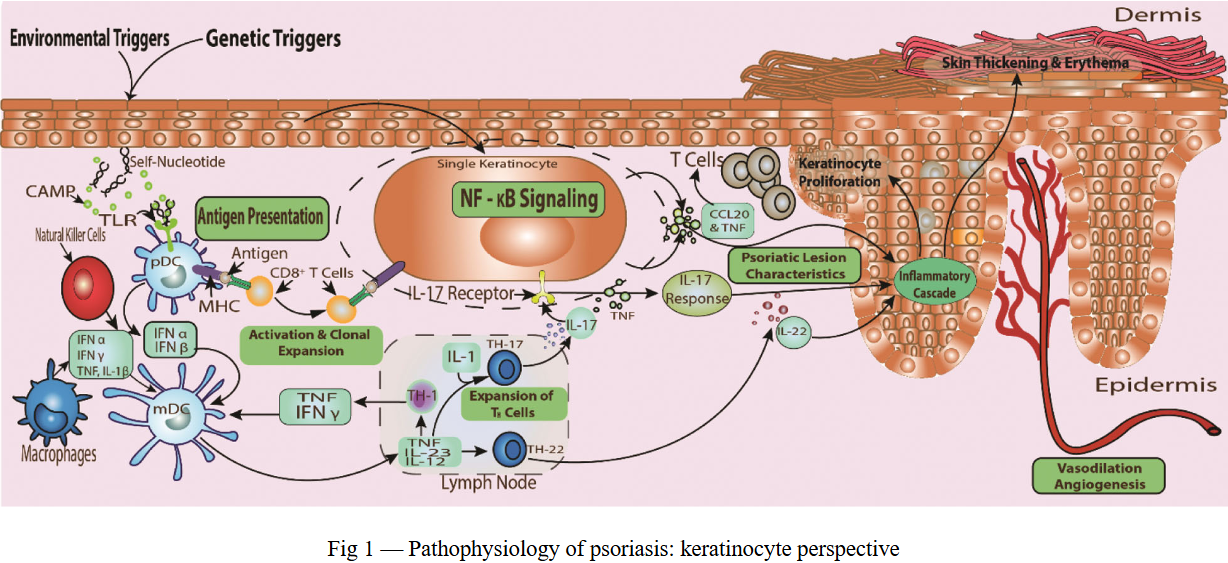Psoriasis is a prevalent chronic, immune-mediated inflammatory skin condition that manifests clinically with red, swollen, and scaly patches or plaques. It is characterized fundamentally by the hyperproliferation of keratinocytes and the dysregulation of cytokine pathways involving various immune cells. Psoriasis is a serious autoinflammatory disease that affects over 125 million people globally and significantly impacts patients’ mental health and overall quality of life.
The current management of psoriasis includes topical, phototherapy, and systemic conventional therapies. However, existing treatments remain limited due to the multifaceted pathophysiological mechanisms of the disease, and no single therapy is entirely compromising. Conventional drugs are often associated with substantial side effects, including a higher risk of infections, hepatotoxicity, and myelosuppression. Topical therapies face challenges such as limited penetration, sensitivity, and the potential for skin atrophy. This scenario highlights a pressing need for novel therapeutic approaches that can target the underlying pathophysiology with reduced toxicity and fewer side effects.Rationale for the Potential Solution
Natural resources, particularly those derived from marine organisms, represent a promising area of exploration for new medicines to treat chronic inflammatory illnesses. Marine-derived active compounds are substantially more abundant than terrestrial resources, given that the ocean covers 70% of the earth and shelters approximately 80% of all flora and fauna. Organisms in the highly competitive and hostile oceanic environment have evolved to produce unique secondary metabolites (such as lipids, peptides, and polysaccharides) as adaptive and host-defense strategies. These substances possess a wide range of beneficial biochemical properties, including anti-inflammatory, antioxidant, and immunomodulatory benefits, making them potential anti-psoriatic agents. Thus, exploring marine natural products offers a distinct and well-exploited perspective for developing effective alternatives for psoriasis treatment.
Key Findings
• Marine Sponges: Sponges are rich sources of biologically active compounds with strong immunosuppressive and anti-inflammatory abilities. Examples include Avarol, which shows anti-psoriatic activity, and Manoalide, which exhibits anti-inflammatory effects by inhibiting phospholipase A2. Furthermore, compounds like Sclerosteroids derived from starfish demonstrate anti-inflammatory properties by blocking the iNOS and COX-2 pathway and the release of eicosanoids.
• Marine Polysaccharides: Compounds like Fucoidan and Fucoxanthin, derived from edible seaweeds, display anti-inflammatory, antioxidant, and immunosuppressive activity. They modulate nitric oxide (NO) production and suppress NF-κB through various signaling pathways (JNK, p38, MAPK, ERK, and AKT).
• Marine Cyanobacteria: Blue-green algae possess potent anti-inflammatory and immunomodulatory properties. Certain derived compounds, such as lipopeptides like Microcolin A and Malyngamides, reveal immunosuppressive action by balancing NO production. These compounds also have antiproliferative effects that help balance the abnormal, rapid skin cell turnover that characterizes psoriasis.
• Terpenoids: These molecules, abundant in marine plants, include Pseudopterosins from the Caribbean Sea whip (Pseudopterogorgia elisabethae), which show analgesic and anti-inflammatory action by blocking eicosanoid and phospholipase A2 biosynthesis.
• Marine Alkaloids: Alkaloids derived from marine organisms, such as Convoluntamydine A (from marine bryozoans) and Hymenialdisine (from sponges), demonstrate anti-inflammatory activity by targeting several steps in the inflammatory cascade, including specifically inhibiting NF-κB and decreasing the production of inflammatory mediators (TNF-α, IL-6).
• Miscellaneous Compounds: Polyunsaturated fatty acids (PUFAs), such as DHA and EPA from fish oils, have proven anti-inflammatory properties by suppressing leukocyte chemotaxis and diminishing the production of eicosanoids.
From a topical perspective, the future implications of this research are highly focused on innovative delivery and production methods. Future directions will involve crafting marine bioactive substances into advanced technologies like nanomedicine, personalized medicine, and multi-omics strategies to enhance their anti-psoriatic potential. Additionally, because certain marine extracts, such as seaweeds, offer nutritional benefits, they can be implemented as oral nutraceuticals to alleviate disease symptoms. However, the development of these therapies faces the key challenge of procuring a streamlined, uniform supply of marine compounds while simultaneously maintaining the fragile marine ecological balance. To overcome this, advanced techniques such as mariculture, aquaculture, and marine biotechnology will play an indispensable role in securing a sustainable resource for drug development.
Link to the study: https://or.niscpr.res.in/index.php/IJBB/article/view/14634/4813


